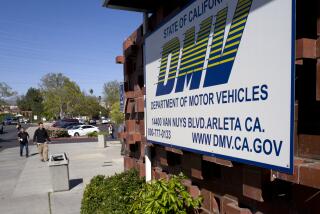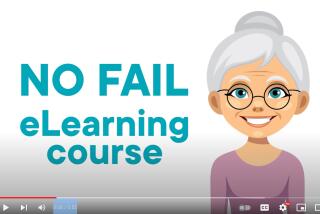Driving Parents Crazy
- Share via
Teenage drivers make up a small fraction--only 3.8%--of California’s driving population, yet they rack up some daunting statistics:
* Sixteen-year-olds have seven times as many car accidents as 24-year-olds.
* Teen car accidents are 2 1/2 times more likely to be fatal or injury accidents.
* Teens speed more and wear seat belts less than adults.
* Teens get twice as many tickets as adults.
* Car crashes are the No. 1 killer of teens in the United States.
It’s these facts that frighten parents the most, but they are not the only concerns about putting a teen on the road.
There’s the cost of driving school, sky-high insurance premiums and all those scary ride-alongs in which parents gasp and hit imaginary brakes while their inexperienced child maneuvers the roadways. Is it all worth it?
Most teens think so and many of their parents would agree.
“It’s nerve-racking,” says Arlene Gold of Calabasas, whose two sons, ages 17 and 19, drive. “I worry when they are even five minutes late, but I did look forward to having my children drive. In fact when they’re with their friends we prefer they drive because we know their driving habits.”
But Gold’s younger son, Brad, says he and his friends often fight about who will drive because no one wants to. “Driving gives you a lot of freedom, but no one wants the responsibly,” he says.
Sixteen-year-old Marisa Edwards of Los Angeles agrees. She’s had a learner’s permit for more than a year and on May 27 will take the Department of Motor Vehicles’ driving test, which she didn’t feel ready for when she turned 16 in January
“Driving hasn’t been a priority for me,” Marisa says. “I was nervous. The truth is I really don’t like to drive.”
Not so her older brother, Marc, who was so anxious to get his license that he counted down the days to his 16th birthday. On that day, he missed school to take the earliest appointment available for his driving test. “Getting rides is a pain,” says the 19-year-old. “Driving makes me feel independent. It’s also a responsibility I enjoy because it takes such a load off my parents.”
California DMV records show that the number of those receiving driver’s licenses in the teenage years has dropped. Boys continue to get their licenses sooner than girls. Yet, Marc and Marisa say most teens they know anticipate getting behind the wheel when they turn 15 and promptly get their licenses shortly after their 16th birthday.
The process can be time-consuming and expensive.
Public schools rarely offer driver’s education anymore. The cost of private driving instruction ranges between $150 and $300. Students can begin the required 30 hours of classwork at age 15, then take a test and apply for a learner’s permit when they are 15 1/2. Passing the 48-question written test allows them to complete their driving training, which entails six hours of behind-the-wheel instruction from a certified instructor. Once teens have a learner’s permit for 30 days, turn 16 years old and can pass the driving test, they can be licensed. A driver’s license costs $15.
A new delegated testing program allows certain driving schools listed with the DMV to not only offer driver training, but also to give the driving test for licenses.
While it is recommended that parents ride with their children to supervise extra practice while they have their learner’s permits, it is not required. Canoga Park DMV licensing examiner Laura Fair says parents need to spend much more time than they do. “Teens need lots of experience in a variety of driving situations, including busy streets and freeway traffic. You can really tell the parents who took the time with their teens on the road. These are the one who pass the test.”
The driving test failure rate stands at 35%, up from 25% three years ago. The test now includes freeway and business district driving, not just suburban neighborhoods. The test lasts 25 minutes as opposed to the 10-minute test given three years ago. Fair says examiners are looking not only for observation of the vehicle codes, but good driving habits.
*
With the license comes a change in the price of the family’s car insurance. Lack of experience, lack of a driving record and teen statistics make teenagers the most expensive drivers to insure, says Jim Armitage, spokesman for Insurance Brokers and Agents of the West. Premiums for a family with a teen driver can cost several thousand dollars a year after factoring in ZIP code, vehicle type and miles per year driven.
Insuring teenage boys costs a few hundred dollars more than girls because boys are three times more likely to be involved in an accident and twice as likely to get a ticket. Armitage says a ticket resulting in one point on a driving record increases insurance costs by 10%. A teen found at fault in an accident becomes classified as a high-risk driver, which can double the premium.
But with many companies, teens can save on insurance costs upfront with good grades, Armitage says. “There is a discount for maintaining a B average or better.”
There is a common misconception that insuring a teen as a secondary driver on the family vehicle will be less expensive than insuring them as a primary driver of their own car.
“If you have high-dollar family vehicles, you might do better to insure your teen separately on a less expensive car,” Armitage says.
In addition, vehicle selection not only saves money, but can cut the fatality risk in half for teenage drivers, says Chuck Hurley with the National Safety Council. “Cars with the three Bs--big, belts and bags--are safest. And size is more important than air bags,” Hurley says. “A good example would be a Taurus or Volvo, both of which can be purchased in the used market for $3,000 or less.”
High-performance sports cars or sport utility vehicles invite high-risk driving, Hurley says. “The typical teen car accident is a single vehicle that loses control. These vehicles have the highest rollover fatality rates.”
The DMV has zero tolerance for teen drinking and driving; the agency will also pull a teen license for two traffic tickets in one year or three tickets in two years.
Safer teen driving is the aim of SB 1329, which if adopted could become law by January 1998. In its current incarnation the bill:
* Requires 16- and 17-year-olds to have 50 hours of driving practice, including 10 night hours, under adult supervision before becoming licensed.
* Prohibits driving with other teens in the car and between the hours of midnight and 5 a.m. without adult supervision for the first six months of licensing. Exceptions are school, work, family or medical necessity. The passenger restriction is lifted during the second six months, and a teen license becomes unrestricted after one year.
Studies show graduated licensing programs have worked well in other states, says Jeffrey Arnett, an associate professor of human development and family studies at the University of Missouri-Columbia who recently published a study about teen driving habits.
Arnett found that sensation-seeking and aggressiveness were related to reckless teen driving habits. “The egocentrism of teens lets them believe they can speed and be safe at the same time,” he says.
Los Angeles Police Officer Ed Melendez, who talks to teenagers regularly about vehicle and traffic safety, finds that teens seem annoyed by strict enforcement of vehicle codes. They forget that the point is to save lives. “Teens need to consider how their driving behavior affects other people on the road,” he says.
(BEGIN TEXT OF INFOBOX / INFOGRAPHIC)
Easy Rider
Driving with a teen who’s learning isn’t easy. Canoga Park DMV licensing examiner Laura Fair has given hundreds of driving tests and is a mother with two children who learned to drive. Here’s her advice to parents:
* Read the reference material provided by the state. It is full of information about good driving habits. Keep the booklet in the car with you during practice runs.
* Practice in empty parking lots at a slow speed. Once your teen gets accustomed to the feel of a car and how it operates, move to the streets. Start on wide, empty roads until you both feel comfortable.
* Do not assume that others on the road always drive correctly or legally.
* Don’t yell. Remember you can still gain control of the car by grabbing the wheel and / or emergency brake if need be.
* Relax and take deep breaths, smile and give plenty of assurance.





